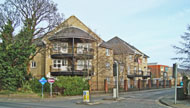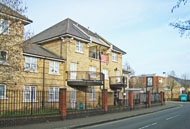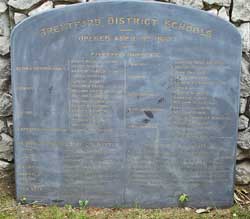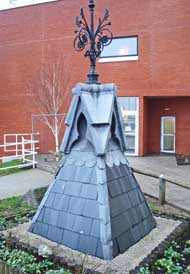Percy House
Auxiliary Military Hospital
Auxiliary Military Hospital
Twickenham Road, Isleworth, Middlesex
Medical
dates:
Medical
character:
Convalescent (military)
Later, geriatric.
Immediately after war had been
declared in 1914, work to organise first-aid training began in earnest
all over the country.
In Middlesex the Oak Room at Hampton Court Palace was used for practice classes, and a Red Cross Voluntary Aid Detachment (V.A.D.) was formed from the residents and neighbours in the vicinity. However, it was announced that the Red Cross would not work in Middlesex. Instead, a St John's V.A.D. - the Middlesex/22 - was formed at Hampton Wick.
Various buildings were suggested for use as auxiliary hospitals but none were found to be suitable. Finally, it was arranged that the Middlesex/22 V.A.D. would work with four other Detachments in the Percy House Schools, an almost empty workhouse school in Isleworth, although this was far from the area. Funds were raised to alter and adapt the building, and to equip and furnish it as a hospital.
The Percy House Schools, lent by the Brentford Board of Guardians, were located to the west of the Brentford Union workhouse. Opened in 1883 by the politician Sir Charles Wentworth Dilke (1843-1911), the Brentford workhouse school had been enlarged in 1901 and renamed Percy House after a local landowner, the Duke of Northumberland. The 2-storey central administration block fronted onto Twickenham Road and contained offices, a chapel, a dining hall, the kitchens and storerooms. Flanking it were 3-storey wings containing accommodation for 280 children (boys in the north wing and girls in the south).
The Percy House Auxiliary Military Hospital opened in October 1915 with 300 beds for sick and wounded servicemen. It was affiliated to the King George Hospital in Stamford Street. The Hospital received a 3 shilling (15p) daily capitation grant per patient.
In 1916 Eastern Command needed another auxiliary hospital and a hotel - the Whitehall Hotel - was found suitable at Hampton Court, a site far more accessible for the Middlesex/22 V.A.D.
By 1917 the number of beds had been reduced to 281.
The Hospital closed on 31st December 1918. During its operational lifetime, some 4,989 wounded servicemen had received treatment. Of these, only one had died.
In 1925 two votive plaques were placed inside the nearby Catholic church of Our Lady of Sorrows and St Bridget of Sweden to bear witness to the recoveries made in 1916 and 1917.
Present status (February 2012)
After the war Percy House was no longer needed as a school as a change of policy meant that children were no longer housed in such large institutions, but boarded out with foster parents or placed in 'scattered homes'. The building was then leased to H.M. Office of Works and used to store military records until 1922.
In 1930 the building transferred to the control of the Middlesex County Council, but remained unused until 1935, when the Council was converted it into 'Part III' accommodation (that is, aged, non-sick former residents of the workhouse that the Council was responsible for under Part III of the National Assurance Act, 1948). Patients were transferred from the nearby Warkworth House, which then became part of the West Middlesex Hospital.
The Home closed in 1975 and the building was demolished in 1978, along with the workhouse.
Today the Percy House Complex, part of the West Middlesex University Hospital, occupies the northern part of the site and new housing in Thackeray Close and Town Field Way the southern part.
In Middlesex the Oak Room at Hampton Court Palace was used for practice classes, and a Red Cross Voluntary Aid Detachment (V.A.D.) was formed from the residents and neighbours in the vicinity. However, it was announced that the Red Cross would not work in Middlesex. Instead, a St John's V.A.D. - the Middlesex/22 - was formed at Hampton Wick.
Various buildings were suggested for use as auxiliary hospitals but none were found to be suitable. Finally, it was arranged that the Middlesex/22 V.A.D. would work with four other Detachments in the Percy House Schools, an almost empty workhouse school in Isleworth, although this was far from the area. Funds were raised to alter and adapt the building, and to equip and furnish it as a hospital.
The Percy House Schools, lent by the Brentford Board of Guardians, were located to the west of the Brentford Union workhouse. Opened in 1883 by the politician Sir Charles Wentworth Dilke (1843-1911), the Brentford workhouse school had been enlarged in 1901 and renamed Percy House after a local landowner, the Duke of Northumberland. The 2-storey central administration block fronted onto Twickenham Road and contained offices, a chapel, a dining hall, the kitchens and storerooms. Flanking it were 3-storey wings containing accommodation for 280 children (boys in the north wing and girls in the south).
The Percy House Auxiliary Military Hospital opened in October 1915 with 300 beds for sick and wounded servicemen. It was affiliated to the King George Hospital in Stamford Street. The Hospital received a 3 shilling (15p) daily capitation grant per patient.
In 1916 Eastern Command needed another auxiliary hospital and a hotel - the Whitehall Hotel - was found suitable at Hampton Court, a site far more accessible for the Middlesex/22 V.A.D.
By 1917 the number of beds had been reduced to 281.
The Hospital closed on 31st December 1918. During its operational lifetime, some 4,989 wounded servicemen had received treatment. Of these, only one had died.
In 1925 two votive plaques were placed inside the nearby Catholic church of Our Lady of Sorrows and St Bridget of Sweden to bear witness to the recoveries made in 1916 and 1917.
Present status (February 2012)
After the war Percy House was no longer needed as a school as a change of policy meant that children were no longer housed in such large institutions, but boarded out with foster parents or placed in 'scattered homes'. The building was then leased to H.M. Office of Works and used to store military records until 1922.
In 1930 the building transferred to the control of the Middlesex County Council, but remained unused until 1935, when the Council was converted it into 'Part III' accommodation (that is, aged, non-sick former residents of the workhouse that the Council was responsible for under Part III of the National Assurance Act, 1948). Patients were transferred from the nearby Warkworth House, which then became part of the West Middlesex Hospital.
The Home closed in 1975 and the building was demolished in 1978, along with the workhouse.
Today the Percy House Complex, part of the West Middlesex University Hospital, occupies the northern part of the site and new housing in Thackeray Close and Town Field Way the southern part.


The Percy House Complex contains the Social Services Department (left) and Twickenham House, for Sexual Health clinics (right).

The main site of the original Percy House site is a car park.


New housing in Thackeray Close.

New housing along Town Field Way, the southern edge of the site.

The commemorative stone for the opening of the Brentford District Schools was laid on 11th April 1883. Known as Percy House, the building was a residential school for children from the old Brentford Union workhouse on the site. The stone is now located in the History Garden of the West Middlesex University Hospital.

One of the finials from Percy House, which was demolished in 1978.
(Author unstated) 1917 List of the various hospitals treating military cases in the United Kingdom. London, H.M.S.O.
Fenn CR 1919 Middlesex to Wit. London, St Catherine Press.
http://en.wikipedia/org
http://postcardsthenandnow.blogspot.com
www.aim25.ac.uk
www.stbridgets.org
www.workhouses.org.uk
Return to home page